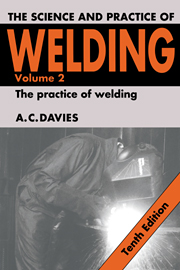Book contents
- Frontmatter
- Contents
- Preface
- 1 Manual metal arc welding
- 2 Gas shielded metal arc welding
- 3 Tungsten electrode, inert gas shielded welding processes (TIG), and the plasma arc process
- 4 Resistance welding and flash butt welding
- 5 Additional processes of welding
- 6 Oxy-acetylene welding
- 7 Cutting processes
- 8 The welding of plastics
- Appendixes
- City and Guilds of London Institute examination questions
- Index
- Frontmatter
- Contents
- Preface
- 1 Manual metal arc welding
- 2 Gas shielded metal arc welding
- 3 Tungsten electrode, inert gas shielded welding processes (TIG), and the plasma arc process
- 4 Resistance welding and flash butt welding
- 5 Additional processes of welding
- 6 Oxy-acetylene welding
- 7 Cutting processes
- 8 The welding of plastics
- Appendixes
- City and Guilds of London Institute examination questions
- Index
Summary
Principles and equipment
(See also pp. 323–5 for general safety precautions)
For oxy-acetylene welding, the oxygen is supplied from steel cylinders and the acetylene either from cylinders or from an acetylene generator which can be of the medium-pressure or low-pressure type.
With cylinder gas, the pressure is reduced to 0.06 N/mm2 or under, according to the work, by means of a pressure-reducing valve and the acetylene is passed to the blowpipe where it is mixed with oxygen in approximately equal proportions, and finally passed into the nozzle or tip to be burnt.
The medium-pressure acetylene generator delivers gas to any desired pressure up to a maximum of 0.06 N/mm2 (0.6 bar) in the same way as cylinder gas.
The low-pressure generator produces gas at a pressure of only a few millimetres water column, necessitating the use of ‘injector’ blowpipes where the high-pressure oxygen injects or sucks the acetylene into the blowpipe. In some cases, as for example if the supply pipes are small for the volume of gas to be carried or if it is desirable to use the equal pressure type of blowpipe, a booster is fitted to the low-pressure generator and the gas pressure increased to 0.06 N/mm2.
Without Home Office approval, the maximum pressure at which acetylene may be used in England is 0.06 N/mm2. With approval, the pressure may be increased to 0.15 N/mm2, but this is rare and applies only in special cases.
- Type
- Chapter
- Information
- The Science and Practice of Welding , pp. 255 - 325Publisher: Cambridge University PressPrint publication year: 1993

